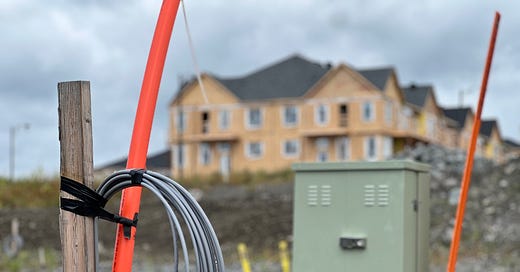Carney's Housing Plan is Good ... But Needs One Addition
Upgrade the Housing Accelerator Fund into a permanent Canada Housing Transfer.
A new housing plan
Recently, Prime Minister Mark Carney released his proposed housing plan. It’s a solid strategy to increase supply and get new homes built.
I’m pleased that the plan picks up on key recommendations for the federal government that Catherine McKenney and I first suggested back in 2023.
But there is one key idea missing.
A systemwide approach
In our Fix Housing series, we published a number of articles on what the federal government should do across the entire housing system:
Set a nationwide plan to build an additional 3.5 million homes
Add a million new affordable homes by 2030 and create new tools to finance them
Recognize what municipalities need to do to complement federal action
Create a new $6 billion Canada Housing Transfer to properly incentivize municipalities
Those recommendations have stood the test of time, and I’m pleased to see the Liberal plan pick up key elements of recommendations 1, 2, 3 and 5. (And I look forward to a forthcoming homelessness plan that picks up on 6 and 7).
The most impactful ideas
I am particularly pleased to see the plan recognize that it is time for the Government of Canada to get back into the business of building homes. I welcome the proposal to stand up a new Build Canada Homes agency. Many of Canada’s housing woes today can be traced back to the federal government exiting the sector in the 1990s.
Here is what we suggested in September 2023:
The federal government should get back into the business of directly building homes.
Specifically, they should be building affordable, sustainable and accessible rental units on surplus federal lands.
The government can contract out construction, maintenance and operations of these units. But the feds should own and oversee them.
The federal government can build housing through standing up a new public builder …
I am also pleased to see the federal government recommending new financing tools for affordable housing builders.
Here is what we suggested in July 2023:
The federal government would provide tools that lower the cost of financing for non-profit builders. This could include creating a multi-billion dollar credit pool for non-profits, secured with the Government of Canada’s AAA credit rating and provided on tenors of up to 50 years, and with a government first loss guarantee. This loan program might cost $2 billion a year. The federal government could also provide subsidies for deeper affordability in some units. That could be another $2 billion, for a total of $4 billion annually. $4 billion a year to get our community housing stock up to 10% of total housing – seems like a bargain.
One key idea is missing: a Canada Housing Transfer
Carney’s plan touches briefly on the fact that municipalities have a critical role in getting housing built. “Gatekeepers” as Pierre Poilieve has been so fond of saying.
But Carney’s plan does not do enough to incentivize municipalities to do better. It includes tweaks to the Housing Accelerator Fund, and reductions to development charges, but it doesn’t do much to motivate municipalities to get serious about building.
We have proposed that the federal government upscale the existing Housing Accelerator Fund into a new $6 billion annual Canada Housing Transfer. It would be similar to the Canada health and social transfers that go to provinces and territories, but it would go instead directly to municipalities (or more technically, it would be distributed as is the Housing Accelerator Fund).
The Canada Housing Transfer would be an annual, direct and unconditional payment to municipalities based on the number and type of housing units completed in the previous year. Cities would get to spend the funds however they wish.
The Housing Accelerator Fund provided a sensible, if perhaps over-complicated, model for how those transfers could be structured.
Here is a first cut at how a new Canada Housing Transfer could disburse funds to municipalities.
Every new home built would result in a base $5,000 payment to the municipality. Homes built near rapid transit or as missing middle infills within existing communities would generate an extra $5,000. Homes that meet the max-30%-of-income affordability definition would generate an additional $5,000. Passive homes would generate a further $3,000. This would incentivize cities to do more of the denser, affordable and low-carbon development that we need.
A municipality would receive from $5,000 to $18,000 for each new home that had been built in the previous year. This money would flow directly to municipalities, without the involvement of provinces and territories.
Get the homes built
I’m happy to see the Prime Minister come forward with a sensible plan for getting homes built. I’m pleased that key elements of the plan align with ideas for which we have been advocating.
Despite best intentions, any federal actions are going to be limited in their impact unless municipalities have a clear incentive to cooperate. Creating a new results-based Canada Housing Transfer would provide municipalities with that incentive.
I’m also looking forward to what the next government will say about solving the related issue of homelessness, and hope they will look closely to our existing proposals on that issue.






The Influence of Urban Infrastructure on Heat — Examples from Monterrey and Mumbai
In cities, land cover is determined by infrastructure — both gray (roofs, pavements) and green (urban forests, street trees, streams and reservoirs). And choices among infrastructure options that provide the same function, like stormwater management, can have very different impacts on land cover (for example, vegetated streams instead of paved drainage channels). The relationship between land cover and heat is a consistent finding in cities and research where WRI has worked to identify cooling solutions. And the absence of cooling land cover is often found in neighborhoods where vulnerable people concentrate — exacerbating inequality in exposure to extreme heat.
Or visit this page...https://www.wri.org/insights/earth-gets-hotter-cool-cities-infrastructure-solutions?apcid=0065832e0841868dfafb8a00&utm_campaign=wridigest&utm_medium=email&utm_source=wridigest-2025-04-09